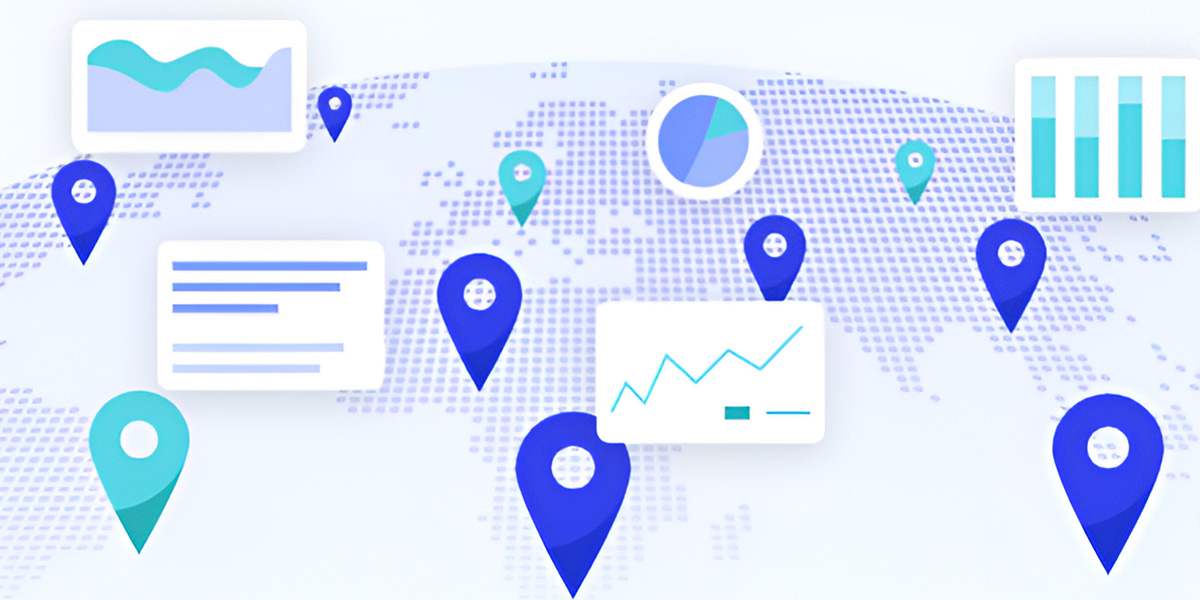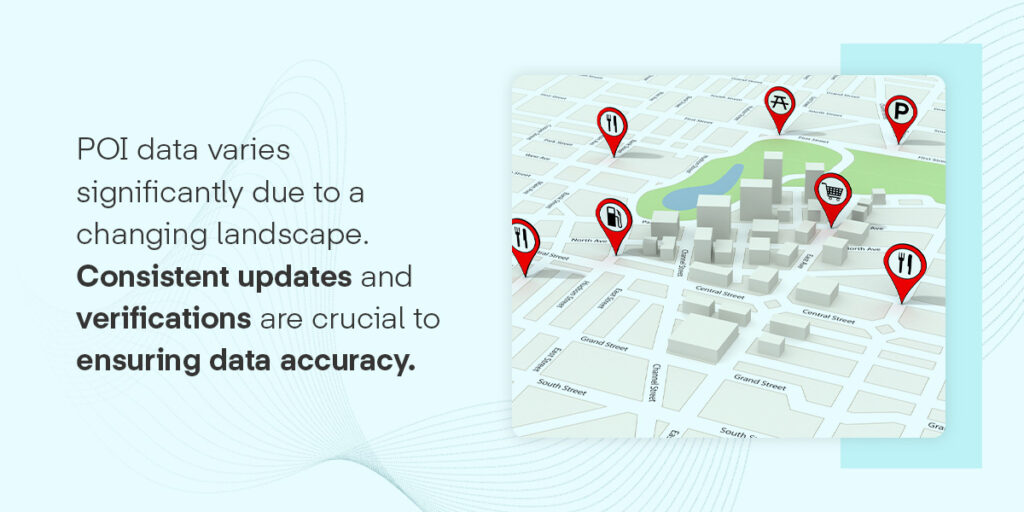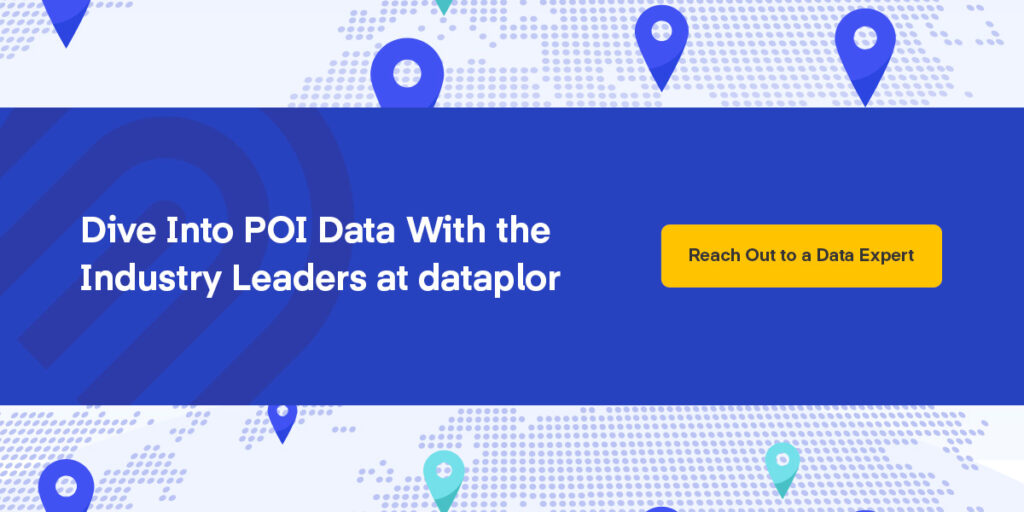
Guide to Point-of-Interest Data
When businesses need to make location-based decisions, they often turn to point-of-interest data. POI is the backbone of many modern tools and data sets, so high-quality data is crucial, but gathering this information can be challenging. Understanding how to collect and compile POI can help you make informed choices when obtaining and using the data for your organization.
What Is POI Data?
Points of interest are any attraction or service people may find exciting or valuable. Some points-of-interest examples include businesses, historical landmarks, parking lots, ATMs, and churches. You access POI data whenever you use a navigation app to get directions on your phone. It shows where these places are and can include metadata with more information, such as the type of business.
Point-of-interest data, meaning compiling this information into a large data set, informs many diverse business processes. Also called place data, POI data usually derives from geographical coordinates. The locations can be permanent, like landmarks and buildings, or temporary, such as a music festival or pop-up restaurant.
Most POI data uses the North American Industry Classification System to identify industry sectors. Business, research, and government applications use NAICS codes. These can tell you if a listing is for a gas station, a retail store, a theater, or something else. When you look at a place listing, this standardized code helps quickly identify its purpose.
How Is POI Data Used?
Businesses use POI in myriad ways, from creating routes to analyzing the competition. POI data can be crucial to location-oriented operational tasks, particularly when combined with GPS tools and geofencing capabilities. Here are a few common ways different industries leverage POI data.
- Telecommunications: The telecom industry heavily relies on POI data to offer insights into service coverage and performance. POI data can inform these maps and provide details for new project decisions, such as where to place cellular towers.
- Finance and insurance: These risk-averse businesses often use POI data to assess different locations. When insuring a new building, they might look into how close it is to a flood zone or an area with high crime rates before determining pricing.
- Real estate: Since real estate depends heavily on location, POI data often informs decisions like where to build new developments or which listings might meet someone’s needs. For instance, a list of nearby amenities comes from POI data.
- Consumer applications: POI data informs many consumer uses, like navigation apps or finding nearby businesses.
- Marketing: Advertisers can use POI data to target specific audiences within an area by leveraging POI data and geofencing.
- Logistics and transportation: Transportation industry businesses rely on POI data to inform navigation tasks, like planning and improving routes. Most organizations with fleets use POI data, such as logistics providers, waste management facilities, and the postal service.
- Retail: Retail stores can use POI data to assess new expansions in a specific area, which can help with performance evaluations and trade area analyses.
- Governments and public services: Governments can also use POI data when evaluating services within an area. They might look for gaps in service offerings or areas where public infrastructure could improve.
POI offers exceptional versatility, especially if incorporated into sophisticated tools designed for these applications.

Where Does POI Data Come From?
With so many business-critical applications, organizations must consider POI data’s source to ensure its quality. Data providers can use varying methods to collect and verify their information. Typical sources include websites, government databases, and human input. These are often prone to errors, such as inaccurate website listings and out-of-date information.
POI data also varies significantly due to a changing landscape. Businesses might close or open, and some owners forget to update their contact details. Buildings and roads are frequently under construction, and areas could get rezoned. Consistent updates and verifications are crucial to ensuring data accuracy.
Addressing these challenges is one of the reasons it’s so vital to find the correct POI data provider. A partner must take steps to verify the information’s accuracy and continuously update it if they find errors or inconsistencies.
Things to Consider When Acquiring POI Data
Getting quality POI means working with a dependable POI provider. If you’ll be working with POI in business, you must consider several aspects of the data and how a company manages it.
- Accuracy and update frequency: Ask your POI provider how they keep their listings correct and current. For example, at dataplor, we use a proprietary system to collect near-real-time updates. In contrast, some companies only update their systems quarterly or annually.
- Verification strategies: Similarly, consider how the company verifies its listings. Look for methods like human verification, error detection systems, artificial intelligence, and machine learning.
- Global coverage: Depending on how you use POI data, you may need global information. Global place data can be particularly challenging to verify due to language differences and limited international resources for United States-based companies. Your POI provider should take special measures for collecting and verifying international data, like enlisting regional experts and using AI data collection. The provider can also simplify global data by using the same data schema for each country.
- Completeness: A data provider might support detailed attributes for each listing, but it doesn’t help you much if there are many blank spaces. Look for a provider with high fill rates to ensure thorough metadata and insights from each listing.
- Modern features: Technologies like AI and machine learning have transformed the world of data collection, and a POI provider should use them to help identify errors or collect information.

Dive Into POI Data With the Industry Leaders at dataplor
High-quality POI data is critical as the foundation of many tasks and business decisions. Some of the world’s largest companies use dataplor’s global, dynamically updated location data to make informed choices. We offer unmatched accuracy and coverage, backed by proprietary technologies and local human validation. Enjoy unique insights with qualitative metrics to learn more about consumer behaviors and brands worldwide.
Whether you need to outpace your competition, boost revenue, expand your services, or meet another goal, we can help. Reach out to a data expert today to learn more about dataplor!


